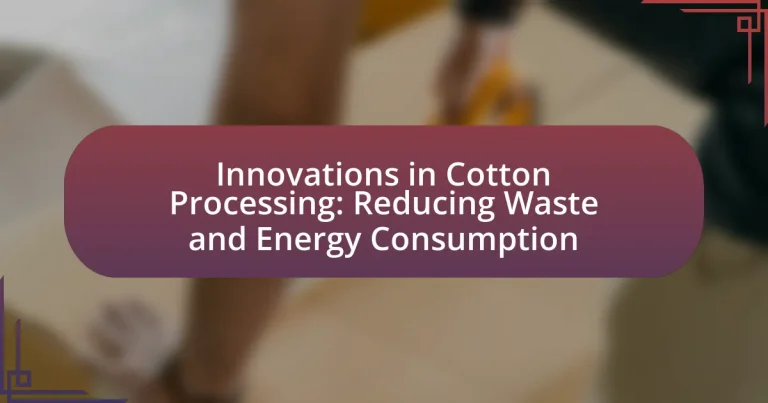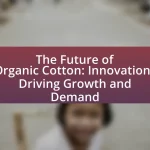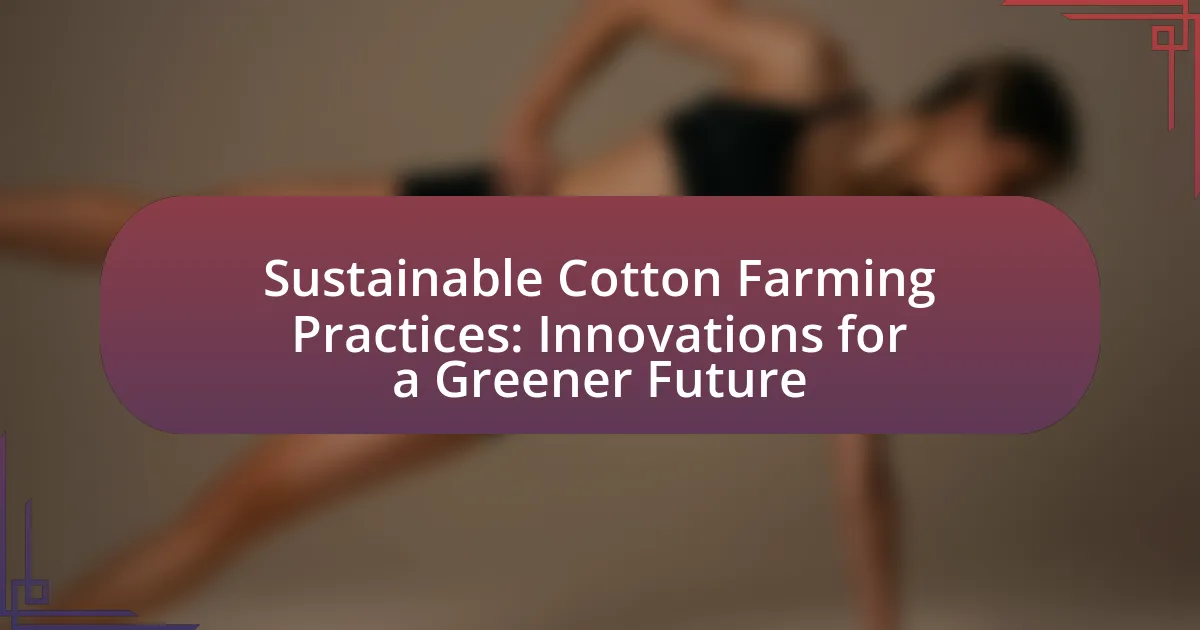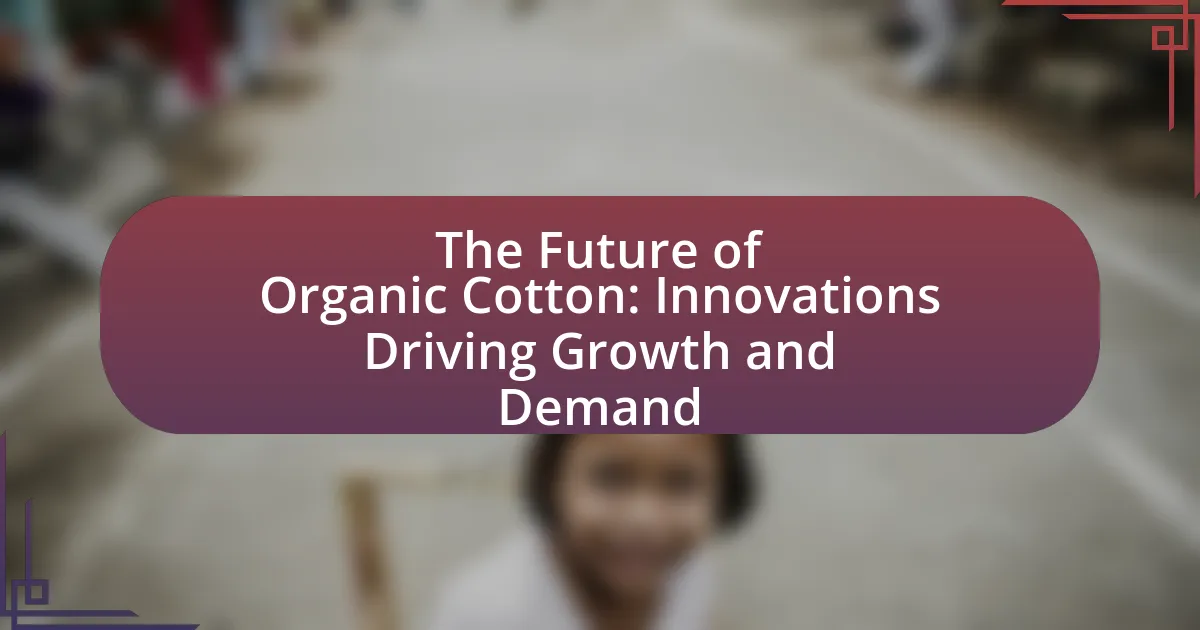The article focuses on innovations in cotton processing aimed at reducing waste and energy consumption. It highlights advanced technologies such as enzymatic treatments and sustainable spinning techniques that significantly lower resource usage and environmental impact. Key topics include the role of automation in enhancing efficiency, the integration of sustainable practices, and the economic implications of adopting energy-efficient technologies. Additionally, the article addresses challenges in implementing these innovations and outlines best practices for effective cotton processing, emphasizing the importance of reducing waste and improving sustainability in the cotton industry.
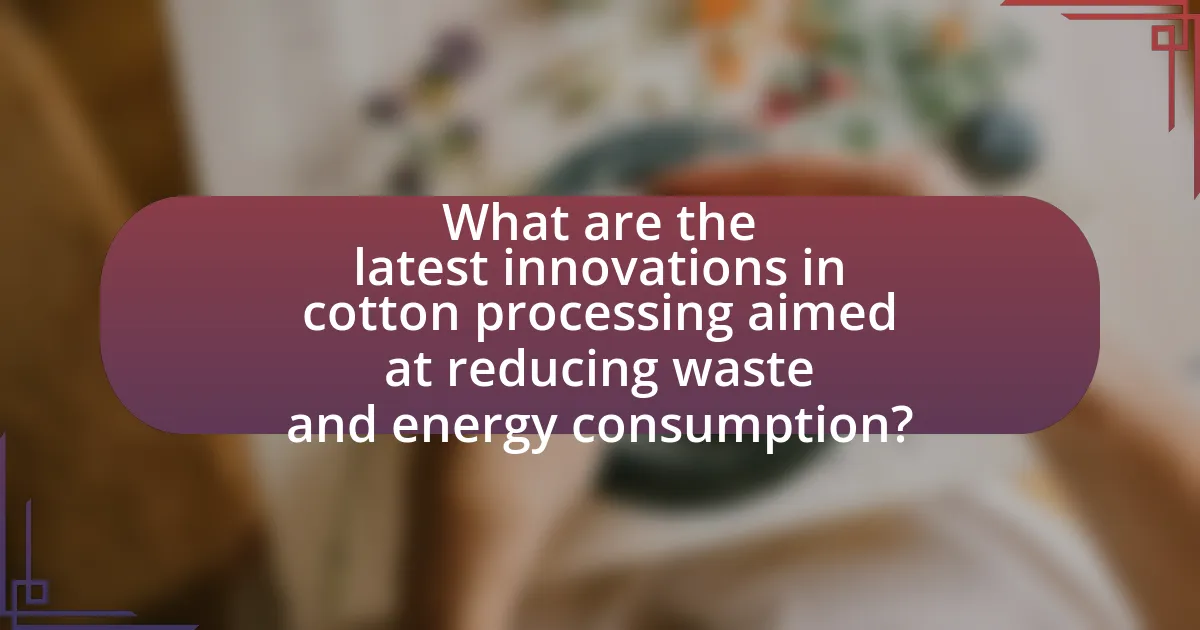
What are the latest innovations in cotton processing aimed at reducing waste and energy consumption?
Recent innovations in cotton processing focus on advanced technologies such as enzymatic treatments and sustainable spinning techniques that significantly reduce waste and energy consumption. Enzymatic treatments utilize specific enzymes to break down cotton fibers, minimizing the need for harsh chemicals and reducing water usage by up to 50%. Additionally, sustainable spinning techniques, including air-jet spinning and rotor spinning, have been developed to lower energy consumption by approximately 30% compared to traditional methods. These innovations not only enhance efficiency but also contribute to a more sustainable cotton industry by decreasing the overall environmental impact.
How do these innovations impact the overall efficiency of cotton processing?
Innovations in cotton processing significantly enhance overall efficiency by reducing waste and energy consumption. For instance, advancements such as automated machinery and precision agriculture techniques streamline operations, leading to faster processing times and lower resource usage. According to a study published in the Journal of Cleaner Production, implementing these technologies can reduce energy consumption by up to 30% and waste by 25%, demonstrating a clear link between innovation and improved efficiency in cotton processing.
What specific technologies are being implemented to minimize waste?
Specific technologies being implemented to minimize waste in cotton processing include advanced spinning techniques, automated sorting systems, and water-efficient dyeing processes. Advanced spinning techniques, such as rotor spinning, reduce fiber waste by maximizing the use of raw materials, achieving up to 99% fiber utilization. Automated sorting systems utilize machine learning algorithms to accurately separate high-quality cotton from waste, significantly decreasing the volume of discarded materials. Water-efficient dyeing processes, like digital printing and closed-loop systems, minimize water usage and chemical runoff, further reducing environmental impact. These technologies collectively contribute to a more sustainable cotton processing industry by lowering waste generation and enhancing resource efficiency.
How do energy-efficient practices contribute to sustainability in cotton processing?
Energy-efficient practices significantly enhance sustainability in cotton processing by reducing energy consumption and minimizing environmental impact. These practices, such as optimizing machinery, implementing renewable energy sources, and improving process efficiencies, lead to lower greenhouse gas emissions and reduced reliance on fossil fuels. For instance, a study by the World Wildlife Fund indicates that energy-efficient technologies can decrease energy use in cotton processing by up to 30%, thereby contributing to a more sustainable production cycle. Additionally, the adoption of energy-efficient practices helps in conserving water and reducing waste, further supporting the overall sustainability goals in the cotton industry.
What role does automation play in modern cotton processing innovations?
Automation plays a crucial role in modern cotton processing innovations by enhancing efficiency and reducing waste. Automated systems streamline various stages of cotton processing, such as ginning, spinning, and dyeing, leading to significant improvements in productivity. For instance, automated ginning machines can process cotton at a rate of up to 10 bales per hour, compared to manual methods that are considerably slower. Additionally, automation minimizes human error and optimizes resource use, contributing to lower energy consumption and waste generation. Studies indicate that integrating automation in cotton processing can reduce energy usage by up to 30%, showcasing its impact on sustainability within the industry.
How does automation reduce labor costs and energy consumption?
Automation reduces labor costs and energy consumption by streamlining processes and minimizing human intervention. In cotton processing, automated systems can perform tasks such as sorting, ginning, and packaging more efficiently than manual labor, leading to a significant reduction in workforce requirements. For instance, a study by the International Cotton Advisory Committee found that automation can decrease labor costs by up to 30% in cotton ginning operations. Additionally, automated machinery often operates at optimal energy levels, reducing energy consumption by 20% to 50% compared to traditional methods, as reported in research by the U.S. Department of Energy. This efficiency not only lowers operational costs but also enhances productivity and sustainability in the cotton industry.
What are the challenges associated with implementing automation in cotton processing?
The challenges associated with implementing automation in cotton processing include high initial costs, technical complexity, and the need for skilled labor. High initial costs arise from the investment required for advanced machinery and technology, which can be prohibitive for smaller operations. Technical complexity involves integrating automated systems with existing processes, often requiring significant adjustments and potential downtime during the transition. Additionally, the need for skilled labor to operate and maintain automated systems can create workforce shortages, as many workers may lack the necessary training or experience. These challenges can hinder the widespread adoption of automation in the cotton processing industry.
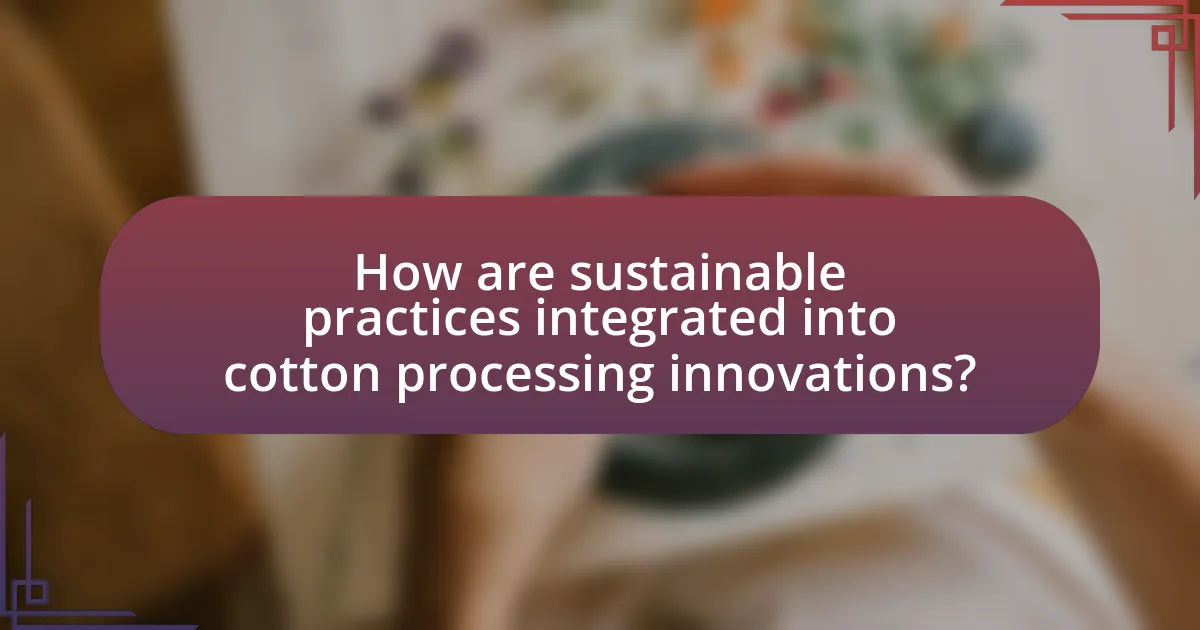
How are sustainable practices integrated into cotton processing innovations?
Sustainable practices are integrated into cotton processing innovations through the adoption of eco-friendly technologies and methods that minimize waste and energy consumption. For instance, innovations such as water-efficient irrigation systems and biodegradable chemicals reduce the environmental impact of cotton cultivation and processing. Additionally, advancements in machinery, like energy-efficient spinning and weaving technologies, significantly lower energy usage during production. According to a study by the Textile Exchange, implementing these sustainable practices can reduce water usage by up to 90% and energy consumption by 30%, demonstrating their effectiveness in promoting sustainability in the cotton industry.
What are the environmental benefits of adopting sustainable cotton processing methods?
Adopting sustainable cotton processing methods significantly reduces environmental impact by minimizing water usage, decreasing chemical pollution, and lowering carbon emissions. For instance, sustainable practices can reduce water consumption by up to 90% compared to conventional methods, as reported by the World Wildlife Fund. Additionally, these methods often utilize organic fertilizers and pest control, which decreases the release of harmful chemicals into ecosystems. Furthermore, sustainable processing techniques can cut greenhouse gas emissions by as much as 30%, contributing to climate change mitigation. These benefits collectively enhance biodiversity and promote healthier ecosystems.
How do sustainable practices affect the quality of cotton products?
Sustainable practices enhance the quality of cotton products by promoting environmentally friendly cultivation and processing methods. These practices, such as organic farming and reduced chemical usage, lead to healthier cotton plants, which produce fibers that are stronger and more durable. Research indicates that organic cotton can have a 20-30% higher tensile strength compared to conventionally grown cotton, resulting in products that last longer and maintain their integrity better. Additionally, sustainable practices often involve improved water management and soil health, which contribute to the overall quality of the cotton fibers harvested.
What certifications or standards are associated with sustainable cotton processing?
Certifications and standards associated with sustainable cotton processing include the Global Organic Textile Standard (GOTS), the Better Cotton Initiative (BCI), and the Organic Content Standard (OCS). GOTS ensures that cotton is grown organically and processed in an environmentally and socially responsible manner, while BCI promotes better practices in cotton farming to reduce environmental impact. The OCS verifies the organic status of cotton and ensures that it is traceable throughout the supply chain. These certifications collectively support sustainable practices in cotton processing, contributing to reduced waste and energy consumption.
How do innovations in cotton processing compare to traditional methods?
Innovations in cotton processing significantly enhance efficiency and sustainability compared to traditional methods. Traditional cotton processing often involves labor-intensive techniques that result in high waste and energy consumption, with estimates indicating that up to 30% of cotton can be lost during processing. In contrast, innovations such as automated spinning technologies and advanced ginning processes reduce waste by optimizing fiber extraction and minimizing damage to the cotton fibers. For instance, modern ginning methods can achieve up to 99% fiber recovery, substantially lowering the amount of cotton discarded. Additionally, innovations like waterless dyeing and energy-efficient machinery contribute to reduced energy consumption, with some new technologies cutting energy use by as much as 50%. These advancements not only improve the overall yield and quality of cotton products but also align with sustainability goals in the textile industry.
What are the key differences in waste generation between traditional and innovative methods?
Traditional methods of cotton processing generate significantly more waste compared to innovative methods. Traditional processing often involves multiple stages that result in higher byproduct rates, such as seed, leaf, and fiber waste, with estimates indicating that up to 30% of the raw material can be lost during these processes. In contrast, innovative methods, such as advanced ginning technologies and bioprocessing techniques, focus on maximizing fiber extraction and minimizing waste, achieving reductions in waste generation by up to 50%. These innovations utilize more efficient machinery and processes that optimize resource use, thereby decreasing the overall environmental impact associated with cotton production.
How does energy consumption differ between these two approaches?
Energy consumption differs significantly between traditional cotton processing methods and innovative approaches aimed at reducing waste. Traditional methods often involve high energy usage due to outdated machinery and inefficient processes, typically consuming around 20-30% more energy per unit of cotton processed. In contrast, innovative approaches, such as the use of advanced technologies like automated systems and energy-efficient machinery, can reduce energy consumption by up to 50%. For instance, a study by the Cotton Research and Development Corporation found that implementing new processing technologies led to a 40% decrease in energy use, demonstrating the effectiveness of these innovations in enhancing energy efficiency in cotton processing.
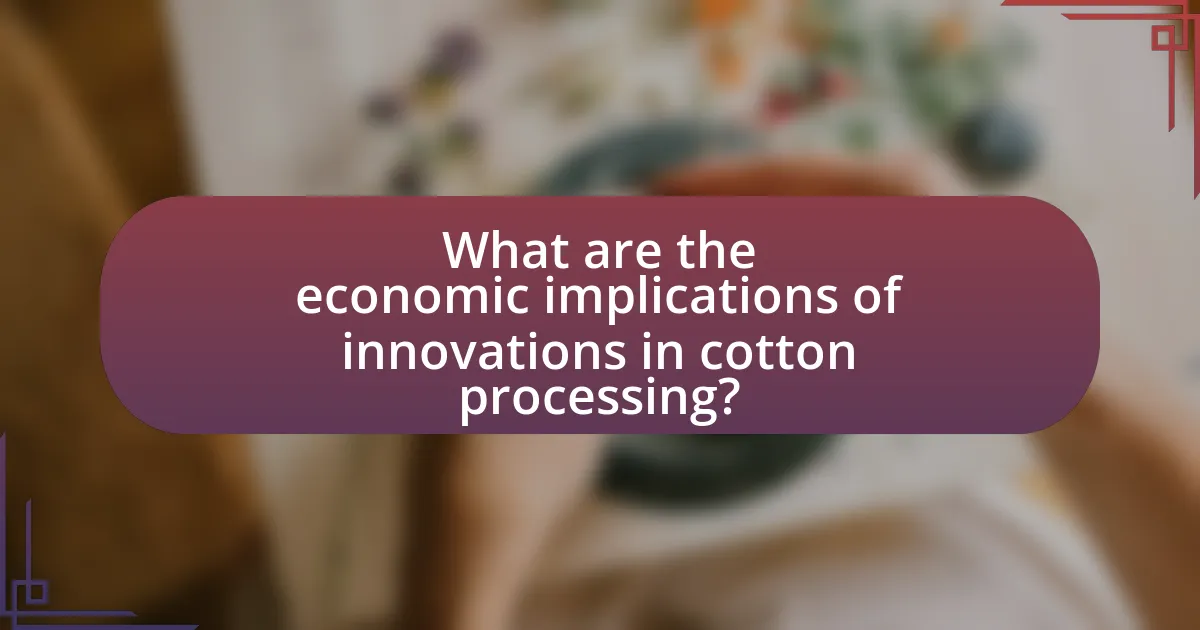
What are the economic implications of innovations in cotton processing?
Innovations in cotton processing significantly enhance economic efficiency by reducing production costs and increasing yield. For instance, advancements such as automated ginning and improved spinning technologies lower labor costs and minimize waste, leading to higher profitability for producers. According to a study by the International Cotton Advisory Committee, these innovations can reduce energy consumption by up to 30%, further decreasing operational expenses. Additionally, enhanced processing techniques can improve the quality of cotton fibers, allowing for higher market prices and better competitiveness in the textile industry. Overall, these economic implications underscore the importance of adopting innovative practices in cotton processing to drive growth and sustainability in the sector.
How do these innovations affect the cost of cotton production?
Innovations in cotton processing significantly reduce the cost of cotton production by enhancing efficiency and minimizing waste. For instance, advancements such as automated harvesting and precision agriculture technologies lead to lower labor costs and optimized resource use. According to a study by the International Cotton Advisory Committee, these innovations can decrease production costs by up to 20% by reducing the amount of water and energy required for cultivation and processing. Additionally, improved processing techniques, like better ginning methods, can yield higher quality cotton with less waste, further contributing to cost savings.
What financial incentives exist for adopting energy-efficient technologies in cotton processing?
Financial incentives for adopting energy-efficient technologies in cotton processing include government grants, tax credits, and low-interest loans. These financial mechanisms are designed to encourage the implementation of technologies that reduce energy consumption and operational costs. For instance, the U.S. Department of Agriculture offers grants through programs like the Rural Energy for America Program, which supports energy efficiency improvements in agricultural operations, including cotton processing. Additionally, tax incentives such as the Investment Tax Credit (ITC) can significantly reduce the upfront costs of installing energy-efficient equipment. These incentives not only lower financial barriers but also promote sustainable practices within the cotton industry, leading to long-term economic benefits.
What are the potential barriers to adopting innovations in cotton processing?
The potential barriers to adopting innovations in cotton processing include high initial investment costs, lack of technical expertise, resistance to change among stakeholders, and insufficient access to financing. High initial investment costs deter many producers from implementing new technologies, as they may not see immediate returns on investment. Additionally, the lack of technical expertise can hinder the effective use of innovative processes, as workers may require training to operate new machinery or systems. Resistance to change is often rooted in established practices and fear of the unknown, making it difficult for stakeholders to embrace new methods. Lastly, insufficient access to financing limits the ability of cotton processors to invest in innovative solutions, as many may rely on traditional funding sources that do not support modernization efforts.
How can stakeholders overcome resistance to change in the cotton industry?
Stakeholders can overcome resistance to change in the cotton industry by actively engaging with farmers and industry players to demonstrate the benefits of innovative practices. For instance, providing training sessions on new processing technologies can help stakeholders illustrate how these innovations reduce waste and energy consumption, ultimately leading to cost savings and increased profitability. Research indicates that when stakeholders involve farmers in the decision-making process and address their concerns, adoption rates for new practices increase significantly. A study by the International Cotton Advisory Committee found that participatory approaches in agricultural innovations led to a 30% increase in technology adoption among farmers.
What best practices can be implemented for effective cotton processing innovations?
Effective cotton processing innovations can be achieved through the implementation of automation, sustainable practices, and data analytics. Automation enhances efficiency by reducing manual labor and increasing processing speed, which can lead to a 20-30% reduction in operational costs, as reported by the International Cotton Advisory Committee. Sustainable practices, such as using eco-friendly chemicals and recycling water, minimize environmental impact and can reduce water usage by up to 50%, according to the World Wildlife Fund. Data analytics allows for real-time monitoring and optimization of processing parameters, improving yield and quality, with studies showing that data-driven decisions can increase productivity by 15-25%.
